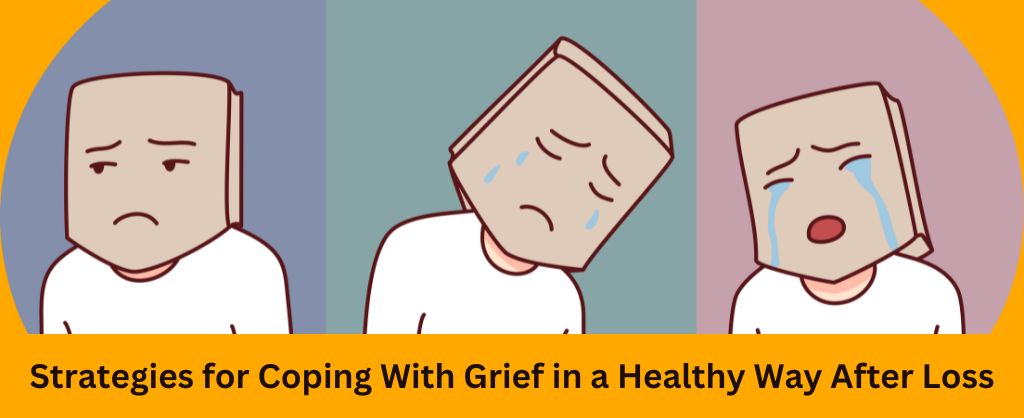7 Healthy Ways to Cope with Grief, Loss and Emotional Pain

Grief. It’s an unavoidable part of life that, at some point or another, touches us all. When we lose someone or something precious to us, the emotional pain can feel unbearable.
Embrace the tears when they come, and yes, concede to wearing pajamas all day if needed.
The ache in our heart seems it may never fade. We find ourselves lost in waves of sadness, heartache, and even regret, anger or fear.
In those moments it seems impossible that we could ever feel joyful again. Life has lost its meaning without the beloved person or plans for the future that are suddenly no more. The pain is real and in those first raw days and weeks, we need to allow ourselves to fully feel it.
Coping with Grief and Loss: Finding Healthy Ways to Heal
Grief must run its natural course. But eventually, we must also take steps to transition from the early intense mourning stage into creating a “new normal” that allows us to move forward while still honoring our loss.
The key is finding healthy and meaningful ways to cope with our sadness on the road to emotional healing.
1. Accept Your Feelings
The first step in grieving well is to fully accept the breadth of emotions that accompany loss. Traditional societal norms often dictate we should “be strong” or “carry on” too quickly. But showing strength means showing our vulnerability and allowing ourselves to fully experience the sadness for a time.
Give yourself permission to cry, to be angry, to pour out questions to the universe over the injustice it sometimes serves us.
Let your feelings flow authentically without judgment or denial. Walking alongside a good friend or counselor who can hold space for your vulnerability can help. Opening your heart in grief to loved ones draws you closer together through shared pain.
2. Do Expect Ups and Downs
Know that the path through grief is not linear. The sadness comes in waves that temporarily overwhelm before receding again.
One day we might feel nearly normal when something suddenly hurls us backwards into heartache again. But eventually those setbacks get further apart until more good days enter than difficult ones.
On darker days, go a bit easier on yourself. Make time for needed rest, comfort foods, and analogies. Watch treasured movies you enjoyed with your loved one. Allow the flow of grief and know you are not backsliding.
The storm will pass again if we ride it out. Brighter moments where we can breathe and even smile a little will steadily return.
3. Embrace Rituals That Bring Comfort
In introducing your new normal, establish rituals of remembrance around your loss that bring purpose and comfort. These self-care routines root you when emotions threaten to unravel progress.
Rituals also give a supportive framework for processing grief. Some find writing letters to lost loved ones cathartic. Include your unsaid thoughts as well as appreciations for special memories made together. This can bring needed closure.
Other rituals that help people move forward include visiting a loved one’s gravesite, planting a garden in their honor, dedicating a bench at a favorite shared spot, or doing meaningful volunteer work annually.
Support groups can provide solidarity when struggling with a loss many share, like losing a spouse, child or sibling. The key is proactively building healthy rituals that encourage emotional expression, connection, meaning or service into your life.
4. Don’t Neglect Self Care
When in the fresh throes of grief, caring for basic needs like eating, sleeping and bathing can feel exhausting. But implementing a few simple self-care practices helps us heal. Make doing light exercise like short neighborhood walks non-negotiable each day—even when you don’t feel like it—as it releases feel good endorphins.
Keep easy grab and go snacks on hand for when you lack motivation to make meals. Set a nightly bedtime for yourself and limit electronics time before bed. And schedule check-ins with supportive friends who you can be totally real with when the heartache hits.
Protecting your physical and emotional reserves gives you strength to keep working through the grief journey.
5. Embrace Beauty and Humor When Possible
Though it might feel impossible early on, look for moments of beauty, humor or meaning that break through the sadness. Capture a sunrise photograph to hang by your bed for moments of hope. Share funny memories or silly quirks of your loved one that make you smile.
Start volunteering with a cause they supported to carry on their legacy. See each small step that lifts your spirits as a win, be it hearing a favorite song or sitting in quiet meditation.
Your capacity to embrace beauty and humor will grow exponentially in coming weeks. Before long, pockets of joy start flowering again from soil fertilized by your tears.
6. When to Seek Help
If unrelenting depression, crippling anxiety, thoughts of self-harm or an inability to function stretch longer than six months post loss, you may benefit from professional support.
Seeking help is not weakness. Therapists specializing in grief counseling equip us with valuable tools when we struggle to independently work through loss.
Getting stuck in any stage of the grieving process happens often. Support groups also provide perspective from others walking similar journeys. We all need a village to lean on.
Prioritizing self-care and healthy community aid us in developing the increased emotional resiliency necessary to integrate loss into our lives.
7. Say Yes to Life
Loss will come wave upon wave over our lives—of dreams, plans, people and seasons. But if we close our hearts to love’s possibilities going forward, fearing further pain, then death claims two lives. The one lost and the life of the survivor unwilling to risk living fully again. Regret is a terrible houseguest we want to avoid.
Instead, after walking through the valley of legitimate grieving, start saying yes to life again little by little. Accept dinner invitations from friends.
Return to hobbies that refresh you. Be open to new possibilities and people coming into your path at the right season. This is not betrayal to the one you lost, but rather choosing to honor their life by embracing the gift that yours still is.
Conclusion
Healing into wholeness after loss requires faithfully walking an intentional path of gentle self-care and courageous vulnerability. By taking ownership of our journey through grief, we come develop into our most authentic, resilient and empathetic selves.
We become a living reflection of the beautiful growth that can emerge in the cracks of even the most broken-hearted places.
The key is stepping forward with that first shaky breath, and then the next. Before long we feel it—a new steadiness building in our soul. Until someday we realize that while the loss will always be part of us, we are truly whole again. And able to companion others we meet walking their own grief journey in gentleness and wisdom. This becoming then elevates how we experience not just our own life, but the collective human experience.
Ultimately grief, when allowed its rightful season, expands our capacity for depth, compassion and living meaningfully. Through loss we connect more profoundly with the borrowed brilliance that this fleeting life is. Out of darkness we each have the power to choose stepping back into the light.
One brave breath, one shimmering moment at a time we can reclaim life. And rediscover that even with sorrow’s scars etching our hearts, joy still waits to take our hand once again. We need only extend it to say yes.










